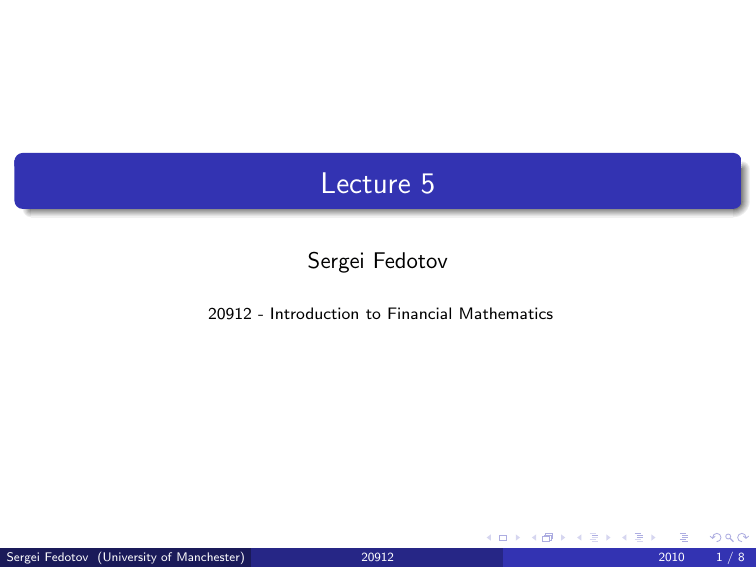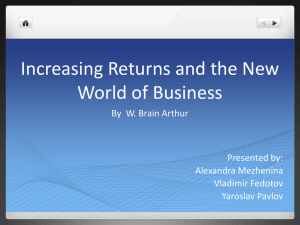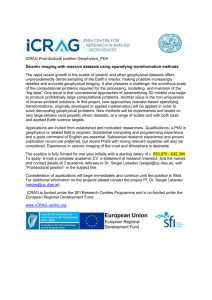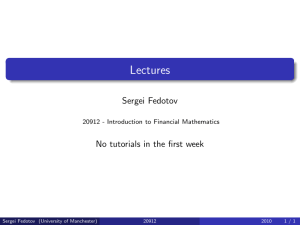Lecture 5
advertisement

Lecture 5 Sergei Fedotov 20912 - Introduction to Financial Mathematics Sergei Fedotov (University of Manchester) 20912 2010 1/8 Lecture 5 1 Trading Strategies: Straddle, Bull Spread, etc. 2 Bond and Risk-Free Interest Rate 3 No Arbitrage Principle Sergei Fedotov (University of Manchester) 20912 2010 2/8 Portfolio and Short Selling Reminder from previous lecture 4. Definition. Short selling is the practice of selling assets that have been borrowed from a broker with the intention of buying the same assets back at a later date to return to the broker. This technique is used by investors who try to profit from the falling price of a stock. Definition. Portfolio is the combination of assets, options and bonds. We denote by Π the value of portfolio. Examples. Sergei Fedotov (University of Manchester) 20912 2010 3/8 Option positions Sergei Fedotov (University of Manchester) 20912 2010 4/8 Trading Strategies Involving Options Straddle is the purchase of a call and a put on the same underlying security with the same maturity time T and strike price E . Sergei Fedotov (University of Manchester) 20912 2010 5/8 Trading Strategies Involving Options Straddle is the purchase of a call and a put on the same underlying security with the same maturity time T and strike price E . The value of portfolio is Π = C + P Sergei Fedotov (University of Manchester) 20912 2010 5/8 Trading Strategies Involving Options Straddle is the purchase of a call and a put on the same underlying security with the same maturity time T and strike price E . The value of portfolio is Π = C + P • Straddle is effective when an investor is confident that a stock price will change dramatically, but is uncertain of the direction of price move. Sergei Fedotov (University of Manchester) 20912 2010 5/8 Trading Strategies Involving Options Straddle is the purchase of a call and a put on the same underlying security with the same maturity time T and strike price E . The value of portfolio is Π = C + P • Straddle is effective when an investor is confident that a stock price will change dramatically, but is uncertain of the direction of price move. • Short Straddle, Π = −C − P, profits when the underlying security changes little in price before the expiration t = T . Sergei Fedotov (University of Manchester) 20912 2010 5/8 Trading Strategies Involving Options Straddle is the purchase of a call and a put on the same underlying security with the same maturity time T and strike price E . The value of portfolio is Π = C + P • Straddle is effective when an investor is confident that a stock price will change dramatically, but is uncertain of the direction of price move. • Short Straddle, Π = −C − P, profits when the underlying security changes little in price before the expiration t = T . Barings Bank was the oldest bank in London until its collapse in 1995. Sergei Fedotov (University of Manchester) 20912 2010 5/8 Trading Strategies Involving Options Straddle is the purchase of a call and a put on the same underlying security with the same maturity time T and strike price E . The value of portfolio is Π = C + P • Straddle is effective when an investor is confident that a stock price will change dramatically, but is uncertain of the direction of price move. • Short Straddle, Π = −C − P, profits when the underlying security changes little in price before the expiration t = T . Barings Bank was the oldest bank in London until its collapse in 1995. It happened when the bank’s trader, Nick Leeson, took short straddle positions and lost 1.3 billion dollars. Sergei Fedotov (University of Manchester) 20912 2010 5/8 Bull Spread Bull spread is a strategy that is designed to profit from a moderate rise in the price of the underlying security. Let us set up a portfolio consisting of a long position in call with strike price E1 and short position in call with E2 such that E1 < E2 . The value of this portfolio is Πt = Ct (E1 ) − Ct (E2 ). At maturity t = T Sergei Fedotov (University of Manchester) 20912 2010 6/8 Bull Spread Bull spread is a strategy that is designed to profit from a moderate rise in the price of the underlying security. Let us set up a portfolio consisting of a long position in call with strike price E1 and short position in call with E2 such that E1 < E2 . The value of this portfolio is Πt = Ct (E1 ) − Ct (E2 ). At maturity t = T ΠT = Sergei Fedotov (University of Manchester) 0, S ≤ E1 , S − E1 , E1 ≤ S < E2 , E2 − E1 , S ≥ E2 20912 2010 6/8 Bull Spread Bull spread is a strategy that is designed to profit from a moderate rise in the price of the underlying security. Let us set up a portfolio consisting of a long position in call with strike price E1 and short position in call with E2 such that E1 < E2 . The value of this portfolio is Πt = Ct (E1 ) − Ct (E2 ). At maturity t = T ΠT = 0, S ≤ E1 , S − E1 , E1 ≤ S < E2 , E2 − E1 , S ≥ E2 • The holder of this portfolio benefits when the stock price will be above E1 . Sergei Fedotov (University of Manchester) 20912 2010 6/8 Risk-Free Interest Rate We assume the existence of risk-free investment. Examples: US government bond, deposit in a sound bank. We denote by B(t) the value of this investment. Sergei Fedotov (University of Manchester) 20912 2010 7/8 Risk-Free Interest Rate We assume the existence of risk-free investment. Examples: US government bond, deposit in a sound bank. We denote by B(t) the value of this investment. Definition. Bond is a contact that yields a known amount F , called the face value, on a known time T , called the maturity date. The authorized issuer (for example, government) owes the holders a debt and is obliged to pay interest (the coupon) and to repay the face value at maturity. Sergei Fedotov (University of Manchester) 20912 2010 7/8 Risk-Free Interest Rate We assume the existence of risk-free investment. Examples: US government bond, deposit in a sound bank. We denote by B(t) the value of this investment. Definition. Bond is a contact that yields a known amount F , called the face value, on a known time T , called the maturity date. The authorized issuer (for example, government) owes the holders a debt and is obliged to pay interest (the coupon) and to repay the face value at maturity. Zero-coupon bond involves only a single payment at T . Return dB B Sergei Fedotov (University of Manchester) 20912 2010 7/8 Risk-Free Interest Rate We assume the existence of risk-free investment. Examples: US government bond, deposit in a sound bank. We denote by B(t) the value of this investment. Definition. Bond is a contact that yields a known amount F , called the face value, on a known time T , called the maturity date. The authorized issuer (for example, government) owes the holders a debt and is obliged to pay interest (the coupon) and to repay the face value at maturity. Zero-coupon bond involves only a single payment at T . Return dB B = rdt, where r is the risk-free interest rate. Sergei Fedotov (University of Manchester) 20912 2010 7/8 Risk-Free Interest Rate We assume the existence of risk-free investment. Examples: US government bond, deposit in a sound bank. We denote by B(t) the value of this investment. Definition. Bond is a contact that yields a known amount F , called the face value, on a known time T , called the maturity date. The authorized issuer (for example, government) owes the holders a debt and is obliged to pay interest (the coupon) and to repay the face value at maturity. Zero-coupon bond involves only a single payment at T . Return dB B = rdt, where r is the risk-free interest rate. If B(T ) = F , then B(t) = Fe −r (T −t) , where e −r (T −t) - discount factor Sergei Fedotov (University of Manchester) 20912 2010 7/8 No Arbitrage Principle The key principle of financial mathematics is No Arbitrage Principle. • There are never opportunities to make risk-free profit Sergei Fedotov (University of Manchester) 20912 2010 8/8 No Arbitrage Principle The key principle of financial mathematics is No Arbitrage Principle. • There are never opportunities to make risk-free profit • Arbitrage opportunity arises when a zero initial investment Π0 = 0 is identified that guarantees non-negative payoff in the future such that ΠT > 0 with non-zero probability. Sergei Fedotov (University of Manchester) 20912 2010 8/8 No Arbitrage Principle The key principle of financial mathematics is No Arbitrage Principle. • There are never opportunities to make risk-free profit • Arbitrage opportunity arises when a zero initial investment Π0 = 0 is identified that guarantees non-negative payoff in the future such that ΠT > 0 with non-zero probability. Arbitrage opportunities may exist in a real market. But, they cannot last for a long time. Sergei Fedotov (University of Manchester) 20912 2010 8/8








